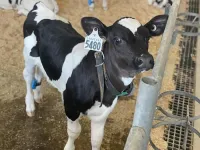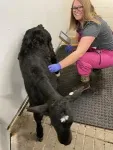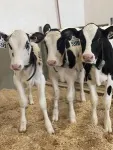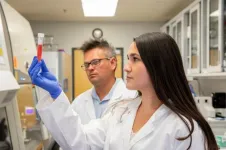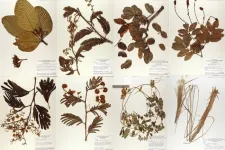(Press-News.org) UNIVERSITY PARK, Pa. — Monitoring dairy calves with precision technologies based on the “internet of things,” or IoT, leads to the earlier diagnosis of calf-killing bovine respiratory disease, according to a new study. The novel approach — a result of crosscutting collaboration by a team of researchers from Penn State, University of Kentucky and University of Vermont —will offer dairy producers an opportunity to improve the economies of their farms, according to researchers.
This is not your grandfather’s dairy farming strategy, notes lead researcher Melissa Cantor, assistant professor of precision dairy science in Penn State’s College of Agricultural Sciences. Cantor noted that new technology is becoming increasingly affordable, offering farmers opportunities to detect animal health problems soon enough to intervene, saving the calves and the investment they represent.
IoT refers to embedded devices equipped with sensors, processing and communication abilities, software, and other technologies to connect and exchange data with other devices over the Internet. In this study, Cantor explained, IoT technologies such as wearable sensors and automatic feeders were used to closely watch and analyze the condition of calves.
Such IoT devices generate a huge amount of data by closely monitoring the cows’ behavior. To make such data easier to interpret, and provide clues to calf health problems, the researchers adopted machine learning — a branch of artificial intelligence that learns the hidden patterns in the data to discriminate between sick and healthy calves, given the input from the IoT devices.
“We put leg bands on the calves, which record activity behavior data in dairy cattle, such as the number of steps and lying time,” Cantor said. “And we used automatic feeders, which dispense milk and grain and record feeding behaviors, such as the number of visits and liters of consumed milk. Information from those sources signaled when a calf’s condition was on the verge of deteriorating.”
Bovine respiratory disease is an infection of the respiratory tract that is the leading reason for antimicrobial use in dairy calves and represents 22% of calf mortalities. The costs and effects of the ailment can severely damage a farm’s economy, since raising dairy calves is one of the largest economic investments.
“Diagnosing bovine respiratory disease requires intensive and specialized labor that is hard to find,” Cantor said. “So, precision technologies based on IoT devices such as automatic feeders, scales and accelerometers can help detect behavioral changes before outward clinical signs of the disease are manifested.”
In the study, data was collected from 159 dairy calves using precision livestock technologies and by researchers who performed daily physical health exams on the calves at the University of Kentucky. Researchers recorded both automatic data-collection results and manual data-collection results and compared the two.
In findings recently published in IEEE Access, a peer-reviewed open-access scientific journal published by the Institute of Electrical and Electronics Engineers, the researchers reported that the proposed approach is able to identify calves that developed bovine respiratory disease sooner. Numerically, the system achieved an accuracy of 88% for labeling sick and healthy calves. Seventy percent of sick calves were predicted four days prior to diagnosis, and 80% of calves that developed a chronic case of the disease were detected within the first five days of sickness.
“We were really surprised to find out that the relationship with the behavioral changes in those animals was very different than animals that got better with one treatment,” she said. “And nobody had ever looked at that before. We came up with the concept that if these animals actually behave differently, then there's probably a chance that IoT technologies empowered with machine learning inference techniques could actually identify them sooner, before anybody can with the naked eye. That offers producers options.”
Contributing to the research were: Enrico Casella, Department of Animal and Dairy Science, University of Wisconsin-Madison; Melissa Cantor, Department of Animal Science, Penn State University; Megan Woodrum Setser, Department of Animal and Food Sciences, University of Kentucky; Simone Silvestri, Department of Computer Science, University of Kentucky; and Joao Costa, Department of Animal and Veterinary Sciences, University of Vermont.
This work was supported by the U.S. Department of Agriculture and the National Science Foundation.
END
Precision technology, machine learning lead to early diagnosis of calf pneumonia
Wearable sensors, automatic feeders yield clues about onset of bovine respiratory disease
2023-07-14
ELSE PRESS RELEASES FROM THIS DATE:
Researchers study lingering Lyme disease symptoms
2023-07-14
An estimated 1,200 Americans, on average, are diagnosed with Lyme disease each day. Some of those patients continue to experience negative effects, even after treatment.
Lyme disease researcher Brandon Jutras, associate professor in the College of Agriculture and Life Sciences and affiliated faculty of the Fralin Life Sciences Institute, recently received a $2.7 million grant from the National Institute of Allergy and Infectious Diseases, part of the National Institutes of Health, to study what causes the disease to linger long after treatment.
“Using a series of sophisticated molecular techniques, in combination with both bacterial and host genetics, we’re working ...
BU cardiologist awarded NIH grant to study impact of environmental toxins on the heart
2023-07-14
(Boston)—Noyan Gokce, MD, professor of medicine at Boston University Chobanian & Avedisian School of Medicine, has been awarded a $453,750 National Institutes of Health (NIH) R-21 grant for his research study “Impact of Per/Polyfluoroalkyl (PFAS) pollutants on vascular disease mechanisms.” This work will be performed in collaboration with co-investigator Jennifer Schlezinger, PhD from the Boston University School of Public Health.
Per- and polyfluoroalkyl substances (PFAS) are manmade chemicals that are extensively used in industrial and consumer products such as stain- and ...
Liverpool chemist wins prestigious Eni Energy Frontiers Award
2023-07-14
Professor Matt Rosseinsky, from the University’s Department of Chemistry and Materials Innovation Factory, has won the 2023 Eni Energy Frontiers Award for the digital design and discovery of next-generation energy materials.
A globally-prestigious prize for research in the fields of energy and environment, previous Eni Award winners include Nobel laureates such as Harold W. Kroto and Alan Heeger.
Professor Rosseinsky’s research is pushing new boundaries in how new energy materials are designed and discovered through the use of digital tools.
For the past 50 years, the scientific approach ...
FSU Research: Colonization influences worldwide distribution of plant specimens
2023-07-14
A study led by a Florida State University researcher that was published in Nature Human Behavior shows how colonization has contributed to the distribution of plants specimens stored in herbaria collections around the world.
Plant diversity in nature is generally highest in tropical regions around the equator, with decreasing diversity closer to the poles. FSU Department of Geography Assistant Professor Xiao Feng and Purdue University Assistant Professor Daniel Park showed that the plant specimens housed in herbaria in Europe and North America are more comprehensive and diverse than the collections housed in the countries ...
Regenstrief researchers elected fellows of prestigious International Academy of Health Sciences Informatics
2023-07-14
INDIANAPOLIS – Regenstrief Institute’s Brian Dixon, PhD, MPA, and Shaun Grannis, M.D., M.S., have been elected as Fellows of the International Academy of Health Sciences Informatics. The organization is an honor society recognizing expertise in biomedical and health informatics around the world.
Election to membership is one of the highest honors in the field. Drs. Dixon and Grannis are two of 21 informatics leaders from around the globe elected to the International Academy in 2023.
In 2021, the two were members of a Regenstrief team whose work to support the public health response to the COVID-19 pandemic was recognized by the ...
Risk assessment for fluoride in groundwater of Mihe-Weihe River Basin——a region with a high fluorine content in the groundwater of Shandong Peninsula in China
2023-07-14
Due to the unclear distribution characteristics and causes of fluoride in groundwater of Mihe-Weihe River Basin (China), there is a higher risk for the future development and utilization of groundwater. Based on the systematic sampling and analysis, a team of researchers from Shandong University of Science and Technology studied the distribution features and enrichment mechanism for fluoride in groundwater by the graphic method, hydrogeochemical modeling, the proportionality factor between conventional ions and factor analysis.
Their analysis is published in the journal Frontiers of Environmental Science & Engineering ...
Ocean animals vacate areas both around and outside deep-sea mining operations
2023-07-14
In 2020, Japan performed the first successful test extracting cobalt crusts from the top of deep-sea mountains to mine cobalt—a mineral used in electric vehicle batteries. Not only do directly mined areas become less habitable for ocean animals, but mining also creates a plume of sediment that can spread through the surrounding water. An investigation on the environmental impact of this first test, published July 14th in the journal Current Biology, reports a decrease in ocean animals both in and around the mining zone.
The International ...
Our favorite vintages and their precarious mountainside homes are at risk due to climate change, environmental scientists warn
2023-07-14
Tucked into the hillsides of Italy, Portugal, and Spain, some of the world’s most famous—and most difficult to maintain—vineyards are heralded for their unique flavor profiles and centuries of tradition. But as extreme weather and changing socioeconomic conditions make this so-called “heroic viticulture” even more challenging, scientists worry these grapes and their cultural histories are at risk. In a Backstory publishing on July 14 in the journal iScience, researchers argue that farmers and scientists must work together to protect ...
One, two, many, lots: Fruit flies can discriminate between numerical quantities
2023-07-14
In the animal world, you don't need to learn a numeral system – such as the ten-digit Indo-Arabic system we commonly use – to be able to count. Animals constantly use numerical information from their environment to make decisions. Estimating the number of conspecifics in a competing group before engaging in conflict, the amount of food available in a difficult-to-reach location, or the number of potential sexual partners in a new territory is essential for survival and reproduction. This skill can reach an astonishing level of refinement; for example, certain species of ants orient themselves ...
Effects of meditation training and non-native language training on cognition in older adults
2023-07-14
About The Study: In this secondary analysis of an 18-month randomized trial that included 135 older adults, meditation and non-native language training did not confer salutary cognitive effects. Although further analyses are needed to explore the effects of these interventions on other relevant outcomes related to aging and well-being, these findings did not support the use of these interventions for enhancing cognition in cognitively healthy older adults.
Authors: Natalie L. Marchant, Ph.D., of University College London, is the corresponding author.
To access the embargoed study: Visit our For The Media website at this link https://media.jamanetwork.com/
(doi:10.1001/jamanetworkopen.2023.17848)
Editor’s ...
LAST 30 PRESS RELEASES:
Tracing the quick synthesis of an industrially important catalyst
New software sheds light on cancer’s hidden genetic networks
UT Health San Antonio awarded $3 million in CPRIT grants to bolster cancer research and prevention efforts in South Texas
Third symposium spotlights global challenge of new contaminants in China’s fight against pollution
From straw to soil harmony: International team reveals how biochar supercharges carbon-smart farming
Myeloma: How AI is redrawing the map of cancer care
Manhattan E. Charurat, Ph.D., MHS invested as the Homer and Martha Gudelsky Distinguished Professor in Medicine at the University of Maryland School of Medicine
Insilico Medicine’s Pharma.AI Q4 Winter Launch Recap: Revolutionizing drug discovery with cutting-edge AI innovations, accelerating the path to pharmaceutical superintelligence
Nanoplastics have diet-dependent impacts on digestive system health
Brain neuron death occurs throughout life and increases with age, a natural human protein drug may halt neuron death in Alzheimer’s disease
SPIE and CLP announce the recipients of the 2025 Advanced Photonics Young Innovator Award
Lessons from the Caldor Fire’s Christmas Valley ‘Miracle’
Ant societies rose by trading individual protection for collective power
Research reveals how ancient viral DNA shapes early embryonic development
A molecular gatekeeper that controls protein synthesis
New ‘cloaking device’ concept to shield sensitive tech from magnetic fields
Researchers show impact of mountain building and climate change on alpine biodiversity
Study models the transition from Neanderthals to modern humans in Europe
University of Phoenix College of Doctoral Studies releases white paper on AI-driven skilling to reduce burnout and restore worker autonomy
AIs fail at the game of visual “telephone”
The levers for a sustainable food system
Potential changes in US homelessness by ending federal support for housing first programs
Vulnerability of large language models to prompt injection when providing medical advice
Researchers develop new system for high-energy-density, long-life, multi-electron transfer bromine-based flow batteries
Ending federal support for housing first programs could increase U.S. homelessness by 5% in one year, new JAMA study finds
New research uncovers molecular ‘safety switch’ shielding cancers from immune attack
Bacteria resisting viral infection can still sink carbon to ocean floor
Younger biological age may increase depression risk in older women during COVID-19
Bharat Innovates 2026 National Basecamp Showcases India’s Most Promising Deep-Tech Ventures
Here’s what determines whether your income level rises or falls
[Press-News.org] Precision technology, machine learning lead to early diagnosis of calf pneumoniaWearable sensors, automatic feeders yield clues about onset of bovine respiratory disease
